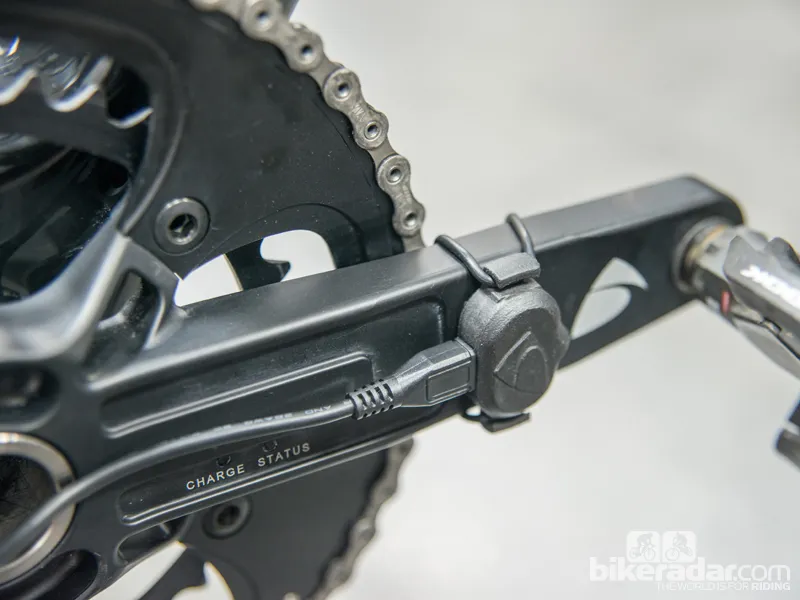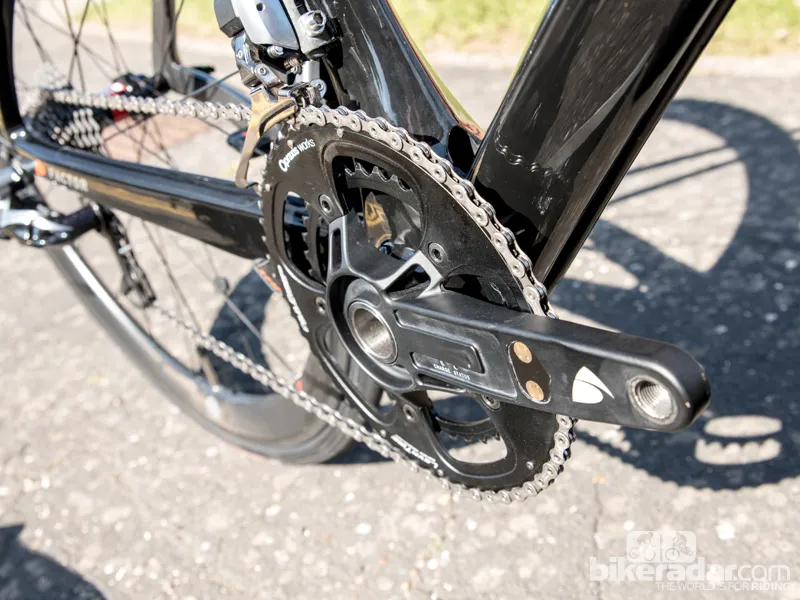Factor Bikes recently launched their new superbike, the Vis Vires, the top spec of which comes with their own crank-based power meter. The Factor Power Crank is going to be made available separately, costing £2,000 when it goes on sale in August. The system transmits data in both ANT and ANT+, making it compatible with Garmin computers and other similar head units.
The Factor Power Crank has eight strain gauges mounted in each crank arm. The gauges are custom made and calibrated at the factory to a tolerance of 0.2 percent. All eight are mounted onto a single backing to ensure perfect alignment. As with SRM and Quarq power meters, Factor’s system requires a magnet on the frame to mark top dead centre. This is built into the Factor Vis Vires frame, along with a speed sensor.
Project leader Simon Roberts gave BikeRadar more detail on how the system works: “We're measuring torque directly at the crank on both sides, and we're also measuring stretch at the crank and angular position in the crank revolution, which enables us to look at pedalling technique in extremely close detail. As well as separate force, torque and power metrics, we can show pedalling efficiency using left-right split, negative force on the rear pedal, and angular velocity.”

The Factor Power Crank system is rechargeable
On top of the additional data acquisition, the system addresses the key practicality issues for power meter users. It's rechargeable, so you don't even need to change a battery yourself, and according to Roberts it's “virtually unaffected” by temperature changes. “Everything we make for motorsport has to work in and around very hot race cars,” he said, “so our temperature compensation techniques are right up there.”
Factor say there is never a need to perform manual zero offsets or calibrations, let alone manually input a conversion slope. Each crankset is calibrated at the factory and that's it. At the start of a ride you just get on and pedal – the Power Crank wakes up when it senses torque on the cranks and immediately connects to your head unit. Because it wakes on torque rather than cadence, it won't go to sleep even if you coast for 20 minutes down a mountain.
Factor Logger or Garmin
The Factor Power Crank can communicate in both ANT and ANT+. The latter allows compatibility with Garmin computers, but the 4hz (four times per second) rate of data transmission can be limiting. Factor have made the best of the ANT+ protocol by having their cranks sample data 96 times per second, averaging 24 data samples into every transmission for a greater level of accuracy.
For even more accurate data capture, they have developed their own head unit. The Factor Logger is able to receive data from the cranks in ANT at 192hz. “The Factor Logger is a post-analysis tool,” said Factor's managing director John Bailey. “Its primary function is to read and store the data from the cranks in ANT, so it also retransmits that data in ANT+ for your Garmin should you prefer to use that while riding.

Garmin users will be able to pair their head unit with the Power Crank system
“The ANT data is really just for post analysis because there's so much data there that you can't read it live. Our long term goal is to have a mk2 Logger that can display even more useful live data, showing exactly what your legs are doing.
“We're working on a partnership with WKO+ [TrainingPeaks analysis software], the new version of which will incorporate a set of algorithms to interpret our high data rate, simplifying it into an understandable set of parameters and saving you from having to wade through dozens of graphs. In our opinion, [power training guru] Hunter Allen is one of the leaders in understanding power measurement, and we're pleased to have that partnership in place.”
The Factor Logger can also transmit via Bluetooth to a PC, for indoor training, showing you detailed live spin analysis if you can set up your bike on a turbo in front of a big screen.
The Logger is due to go on sale in October, alongside the release of what will presumably be WKO+ 4.0. The head unit will be available both on its own and as a package with the Power Crank and PC software. Prices are still to be confirmed but the full package is likely to cost around £3,000.
The Power Crank is designed for BB386 and can fit almost any frame using the supplied adaptors. Crank lengths of 170, 172.5 and 175mm will be offered. The first batches will be in 130BCD only, with a compact version to follow. The Power Crank is claimed to weigh 840g for a 172.5mm crankset with 53/39 rings.
High speed electronics specialists
Factor Bikes are part of bf1systems, an electronics company specialising in strain gauge applications and wireless tyre pressure monitoring for motorsport, including Formula 1. In 2009, bf1systems showed the Factor 001 concept bike, complete with their own power meter.
“That bike opened doors for us with teams and national federations who were interested in our power meter,” Bailey told BikeRadar. “After that we thought, 'Yeah, we've got something here.' Once we started talking to Hunter Allen we appreciated how huge the power measurement market is.”
If any proof were needed, a look around bf1systems' HQ reveals the depth of their expertise in this field. The motorsport applications they have for strain gauges make bicycle power meters look like children's toys.
On a tour of their facility we were shown an incredibly light carbon fibre steering shaft for an LMP1 Le Mans race car that had strain gauges to measure the driver's steering force. We also saw also a bracket for a Formula 1 car's front wing, with strain gauges to measure the vertical down force, rearward drag and centre of down force pressure on the wing separately. Clever stuff.
